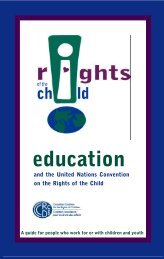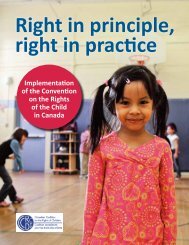Poste - Canadian Coalition for the Rights of Children
Poste - Canadian Coalition for the Rights of Children
Poste - Canadian Coalition for the Rights of Children
Create successful ePaper yourself
Turn your PDF publications into a flip-book with our unique Google optimized e-Paper software.
C A N A D I A N C O A L I T I O N F O R T H E R I G H T S O F C H I L D R E N<br />
Provincial/Territorial Curricula: Culture, Language, National Values and O<strong>the</strong>r Civilizations<br />
British Columbia:<br />
• Undertook ef<strong>for</strong>ts in 1996 to improve program access, relevance and success <strong>for</strong> Aboriginal students 84<br />
• In 1995, family life education was introduced to develop students’ understanding <strong>of</strong> <strong>the</strong> role <strong>of</strong> <strong>the</strong> family and<br />
responsible decision-making. 85<br />
• Social Studies curriculum covers factors that have shaped Canada, citizen rights and responsibilities, diverse<br />
patterns <strong>of</strong> human activity around <strong>the</strong> world and tolerance, caring and respect <strong>for</strong> o<strong>the</strong>rs. 86<br />
• Four Social Studies credits are required <strong>for</strong> a high school diploma.<br />
• Language courses include Japanese and Mandarin.<br />
Saskatchewan:<br />
• Indian and Métis Education Development Fund assists rural schools in providing enhanced programs and services. 87<br />
• Citizenship and <strong>Canadian</strong> government courses are included at <strong>the</strong> different grade levels. 88<br />
• Social Studies courses cover families, global education and <strong>Canadian</strong> studies.<br />
• Language courses include Cree, Dené, German, Japanese, Saulteaux, Spanish and Ukrainian.<br />
• Cultural Heritage programs are available, in a limited fashion, to high school students <strong>for</strong> credit. These courses<br />
include: Asian Studies, Indian Literature, Métis Studies, Native Studies, Native Education, Native Traditions, Pacific<br />
Rim Studies and Woods Cree Culture. 89<br />
Ontario:<br />
• Arts courses examine artistic traditions <strong>of</strong> various cultures. 90<br />
• Health discusses healthy relationships. 91<br />
• Social Studies looks at interactions between various cultural groups in Canada and in <strong>the</strong> world.<br />
• History and Geography study diverse groups contributing to Canada’s historical, cultural and economic<br />
development. 92 Native Studies and World Religions are also <strong>of</strong>fered.<br />
• International Languages Program provides 70 language courses in 69 elementary school boards. 93<br />
Quebec:<br />
• Obligatory instruction in languages and social sciences to expose students to history, citizenship, geography and<br />
economics, art, and moral and religious education. 94<br />
• The Kativik Regional School Board in nor<strong>the</strong>rn Quebec requires students to be taught in Inuktitut until Grade 3,<br />
when English or French is taught as a second language. 95<br />
Nova Scotia:<br />
• Personal Development teaches respect <strong>for</strong> different genders and social backgrounds and confronting racism.<br />
• Family Studies examines relationships and historical perspectives while sociology includes study <strong>of</strong> <strong>the</strong> family and<br />
minority groups.<br />
• Gaelic Studies <strong>of</strong>fered in Grades 3 to 6; German, Latin and Spanish <strong>of</strong>fered in high school.<br />
• Social Studies includes examination <strong>of</strong> anti-racism, multiculturalism and interculturalism (Junior High).<br />
• Mi’kmaq education promotes understanding <strong>of</strong> <strong>the</strong> Mi’kmaq peoples. 96<br />
Alberta:<br />
• Grade 10 social studies focuses on <strong>Canadian</strong> citizenship. 97<br />
• Bilingual programs in Ukrainian, Arabic, Mandarin, German, Polish and Hebrew allowing <strong>for</strong> one <strong>of</strong> several<br />
languages to be used <strong>for</strong> instruction from 25 to 50 percent <strong>of</strong> <strong>the</strong> school day.<br />
• 15 languages are taught as provincial or locally-developed courses. 98<br />
86




